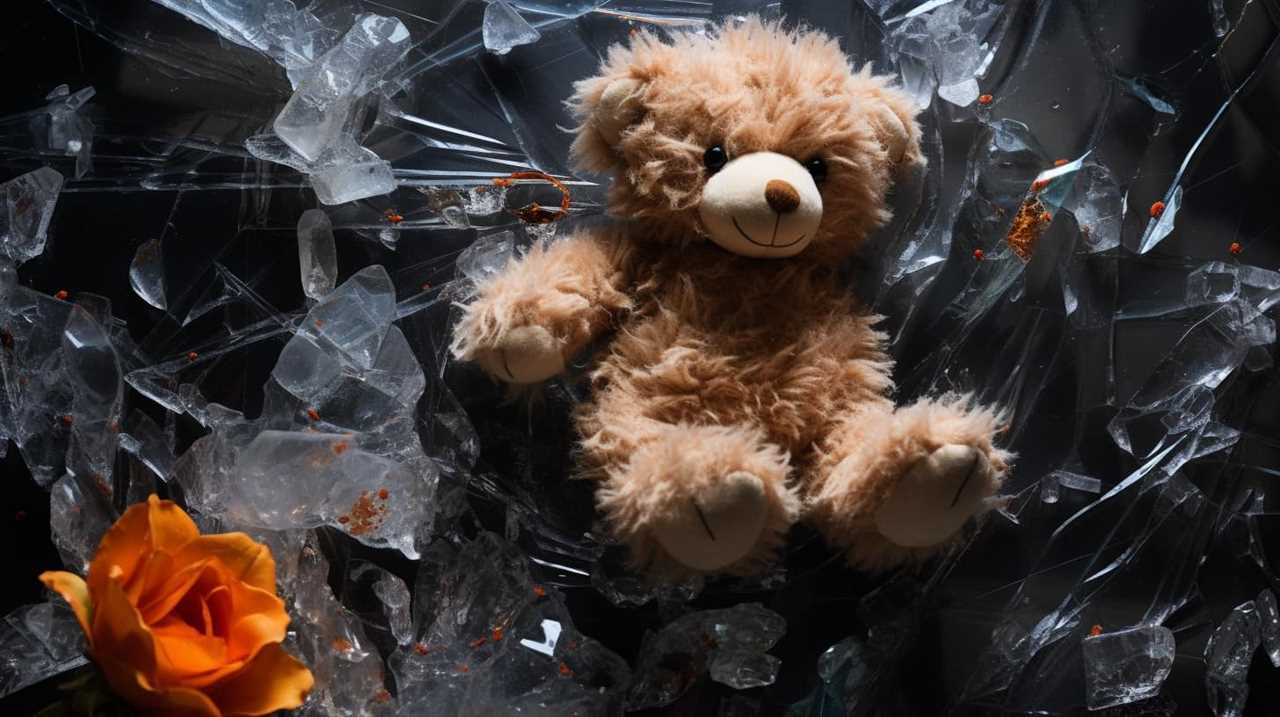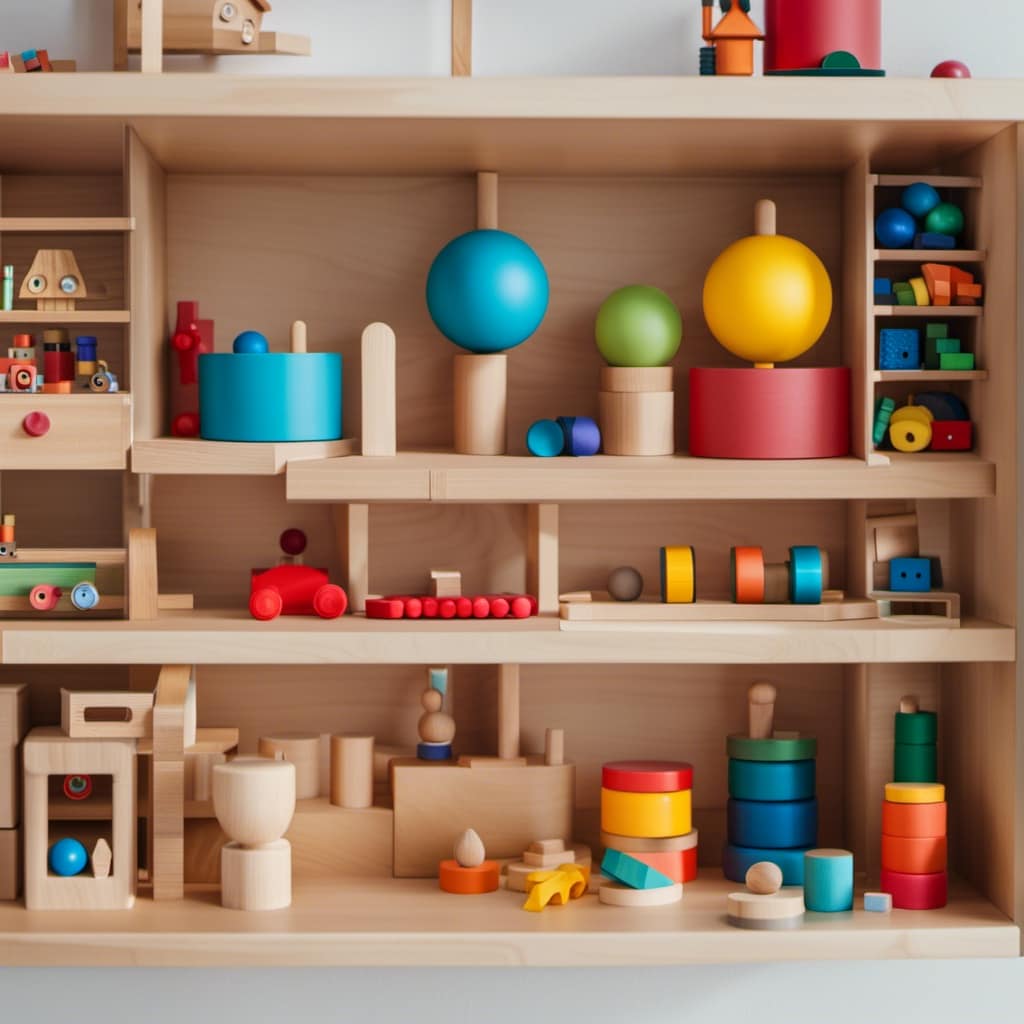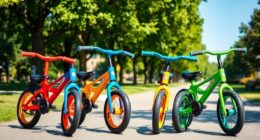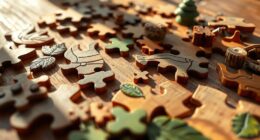When choosing Montessori toys, prioritize safe, natural materials like wood, organic cotton, or bamboo to protect your child’s health and promote safe exploration. Avoid toys with bright paints, plastic parts, or glued decorations that might contain toxins. Make sure toys have smooth edges and are the right size to prevent choking. Durable and well-maintained toys support long-term safe play, helping your child develop confidence and fine motor skills. Keep these tips in mind to create a safe, enriching environment—more details await you.
Key Takeaways
- Select toys made from natural, non-toxic materials like wood, organic cotton, or bamboo to ensure safety and sensory engagement.
- Verify labels and certifications to confirm toys are free from harmful chemicals and meet safety standards.
- Ensure toy sizes are appropriate for the child’s age to prevent choking hazards.
- Avoid toys with bright paints, plastic parts, or glued decorations that may contain toxic substances.
- Regularly inspect and maintain toys, replacing any damaged or worn items to promote safe, durable play.

When choosing Montessori toys for your child, safety should be your top priority. You want toys that not only promote learning but also protect your child’s health and well-being. Montessori toys are designed to encourage child-led learning, where children explore the world at their own pace and develop important skills naturally. To support this approach, select toys made from natural, non-toxic materials that are free from harmful chemicals. These materials are less likely to cause allergic reactions or pose choking hazards, giving you peace of mind as your little one engages in play.
Opt for toys crafted from wood, organic cotton, or bamboo, as these materials are durable, sustainable, and safe for sensory exploration. Natural materials provide a more authentic sensory experience, allowing your child to feel different textures, weight, and warmth, which is essential for sensory development. When children handle natural toys, they learn to differentiate between textures and develop fine motor skills through grasping, squeezing, and manipulating the objects. This hands-on interaction is a core part of sensory exploration, helping your child refine their senses and understand their environment better.
Natural materials like wood, cotton, and bamboo enrich sensory play and support fine motor skill development.
Avoid toys with bright paints, plastic parts, or glued-on decorations that might contain toxic substances. Always check labels and certifications to ensure the materials are food-grade or meet safety standards. Toys with smooth, rounded edges are preferable to prevent any injuries during active play. Additionally, consider the size of the toy—nothing too small that could be swallowed or cause choking. Montessori toys should be appropriately sized for your child’s age and developmental stage, supporting safe and independent play.
Another important aspect of safety is durability. Natural materials like wood tend to hold up better over time compared to plastic, which can crack or break into sharp edges. Well-made Montessori toys withstand rough handling and still remain safe for repeated use. Regularly inspect toys for signs of wear or damage, and remove any that could pose a hazard. Keep in mind that the goal of Montessori toys is to empower your child to explore their world confidently. By choosing safe, natural materials, you’re fostering an environment where your child can freely engage in sensory exploration and child-led learning without unnecessary risks. Additionally, selecting toys made from safe, non-toxic materials aligns with recommended safety standards and supports your child’s overall well-being.
Frequently Asked Questions
Are All Natural Materials Equally Safe for Children?
Not all natural materials are equally safe for children, especially when synthetic coatings or chemical treatments are involved. You should carefully check if the materials have been treated with harmful substances, as these can pose health risks. Always opt for toys made from untreated, organic, or natural sources, and guarantee they’re free from synthetic coatings or chemical treatments. This way, you protect your child’s health while encouraging safe, natural play.
How Can I Identify Non-Toxic, Eco-Friendly Toy Finishes?
Did you know that over 80% of toxic chemical exposures in children come from household products? To identify non-toxic, eco-friendly toy finishes, look for labels specifying safe, non-toxic coatings. Check for certifications like Greenguard or FSC. Opt for natural wood finishes such as beeswax or mineral oil, and avoid finishes with synthetic chemicals. Always research brands and ask about the ingredients to guarantee the safety of your child’s toys.
What Certifications Should I Look for in Montessori Toys?
When selecting Montessori toys, you should look for certification labels that verify safety and eco-friendliness. Focus on material standards like ASTM or EN71, which ensure toys meet rigorous safety requirements. These certifications confirm that the toys are free from harmful chemicals and safe for children. Always check for clear, reputable labels on the packaging, so you can confidently choose toys that support both your child’s development and environmental health.
Can Natural Materials Cause Allergic Reactions in Children?
You might find it surprising, but natural materials can sometimes cause allergic reactions. However, choosing hypoallergenic materials helps prevent allergies, ensuring your child’s safety. Always check for allergy prevention strategies, like avoiding known irritants. While natural materials are generally safe, it’s smart to observe your child’s reactions and consult with a pediatrician if you notice any signs of allergies. This way, you protect your child while supporting their healthy development.
How Often Should Montessori Toys Be Inspected for Safety?
You should inspect your Montessori toys regularly to guarantee safety. Check for toy wear, such as cracks, splinters, or loose parts, at least once a month. Incorporate a cleaning schedule that includes cleaning and disinfecting toys after each use or weekly, depending on how often they’re played with. Consistent inspections and cleaning help prevent accidents and keep toys safe, durable, and inviting for your child’s development.
Conclusion
By choosing Montessori toys made from safe, natural materials, you’re not just protecting your child—you’re nurturing their curiosity and growth. Think of these toys as seeds of learning, growing stronger with your mindful choices. When safety and sustainability lead the way, you create a world where playtime becomes a journey of discovery, not danger. So, trust your instincts and remember: the safest toys are the ones that truly care for your child’s well-being.











